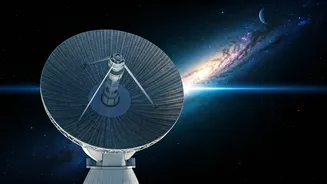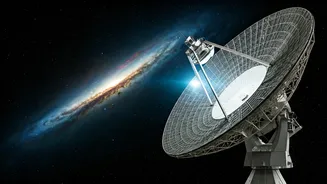Unveiling 3I/ATLAS
The interstellar object, designated 3I/ATLAS, has captivated the scientific community due to its unique trajectory and origin outside our solar system.
The recent detection of a radio signal emitted by this celestial wanderer has opened a new window into its nature. This marks the first time such a signal has been successfully detected from an interstellar object, providing invaluable data for analysis. The nature of the radio signal itself is a key area of study, with scientists examining its frequency, intensity, and duration to extract as much information as possible about the object's composition, structure, and formation environment. This extraordinary observation has the potential to rewrite existing theories about the formation of planetary systems and the distribution of matter throughout the universe. Furthermore, these signals can help to distinguish between natural phenomena and potential artificial or technological sources.
Radio Signal Insights
The radio signal detected from 3I/ATLAS provides a wealth of information about its origin. Analyzing the signal helps researchers understand the object's composition and how it came into being. Scientists are keenly studying its characteristics to gain insights into its potential link to other objects, such as asteroids, comets, or even exoplanets. The discovery of this radio signal adds a new dimension to our comprehension of the vast universe, revealing how various celestial bodies behave and communicate. This study presents new data and opportunities to assess if the signal is naturally produced or if its origins are more complex. Moreover, the radio emission may provide crucial information about the object's environment when it formed and the evolutionary path it took to become an interstellar traveler, giving insights into its interactions with other cosmic elements.
Origins of 3I/ATLAS
Scientists speculate that 3I/ATLAS might have originated from a planetary system beyond our own, possibly ejected from its host star due to gravitational interactions. This theory is supported by the object's high velocity and unusual orbit. The analysis of the radio signal will contribute to identifying the location and circumstances of this ejection. Research into the characteristics of the object will also improve our ability to differentiate it from objects created within our own solar system. This is a very critical step to ensure that we are correctly interpreting data and drawing proper conclusions. Understanding the origin of 3I/ATLAS would provide valuable insights into the diversity of planetary systems, the process of planetary formation, and the potential for life beyond Earth. The implications of this research extend far beyond the specific findings about 3I/ATLAS; it offers a look into how the universe works and opens avenues for new discoveries.
Future Research Directions
Future research on 3I/ATLAS will explore various aspects of the object, like its surface properties, internal structure, and composition. The plan is to employ advanced telescopes and observational techniques to gather additional data on its radio emissions. Additionally, scientists may attempt to correlate the findings with other observations, such as those obtained by other space telescopes or ground-based observatories. They hope this will allow them to create a full picture of the interstellar object. They are trying to find potential similarities between 3I/ATLAS and known objects within our solar system. The aim is to build a detailed and comprehensive understanding of the object, its origin, and its journey through interstellar space. This will assist scientists in refining their models and hypotheses to fully explain this astonishing cosmic encounter and the complex interactions of the cosmos.













